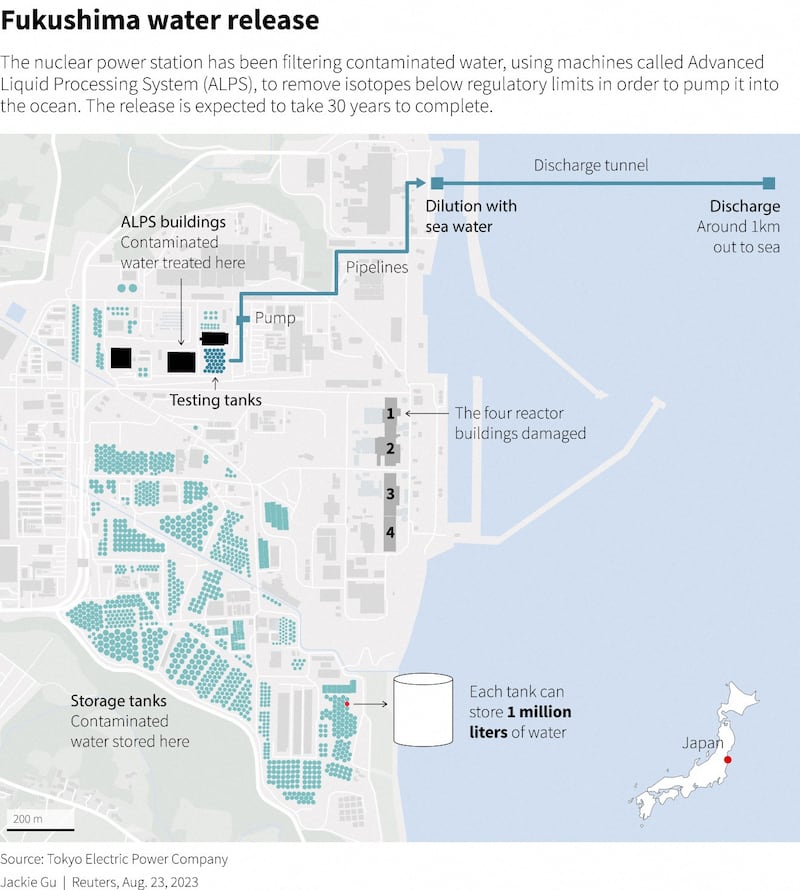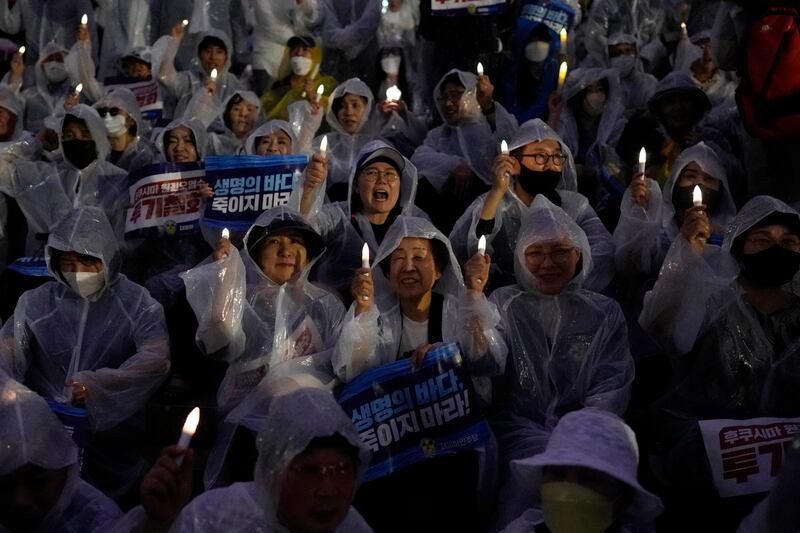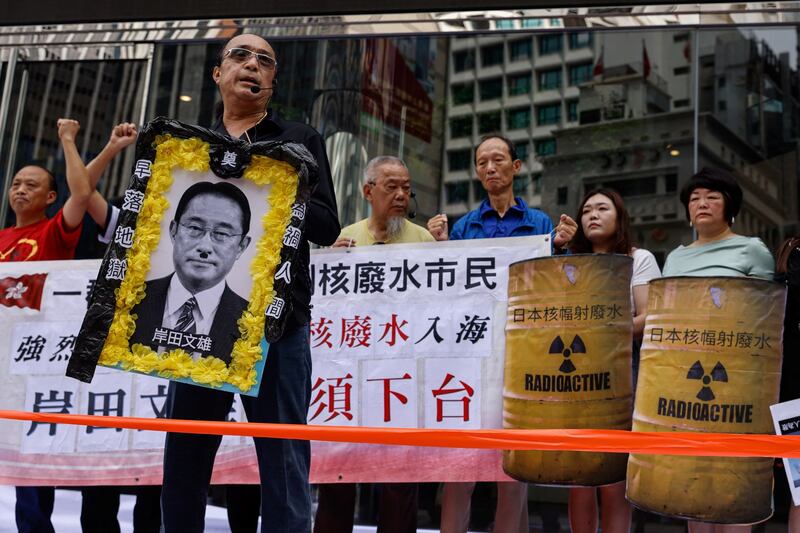UPDATED AT 10:05 pm ET on 2023-08-24
Japan has started the gradual release of treated radioactive wastewater from the damaged Fukushima Daiichi nuclear power plant into the Pacific Ocean, despite regional and local concerns, with plans to eventually pump more than a million metric tons of it into the sea.
The release comes 12 years after the nuclear accident following an earthquake and tsunami, leading to a plant meltdown. According to authorities, the water used to cool the nuclear reactors and additional groundwater and rainwater seeping into the reactor buildings has reached near full storage capacity.
TEPCO, the Tokyo Electric Power Company, which operates the power plant located on Hakura Beach in Japan, said Thursday it began the discharge at around 1 pm (04:00 GMT).
Only around 200 or 210 cubic meters of treated wastewater is expected to be released on the first day, TEPCO told reporters earlier on Thursday. However, starting Friday, it plans to increase the release to 7,800 cubic meters over 17 days.
If any irregularities in the discharge equipment or the dilution rates of the treated wastewater are observed, the operation will be halted at once, TEPCO said, adding it will also collect samples from nearby harbor water to monitor and ensure the discharged, treated wastewater meets international safety standards.
The U.N.’s atomic watchdog, the International Atomic Energy Agency (IAEA), said last month the planned discharge of wastewater meets relevant international safety standards and would have a “negligible” radiological impact on people and the environment.
“Even if it takes several decades, the government will take responsibility until the treated water is fully disposed of,” Japanese Prime Minister Fumio Kishida said on Tuesday, announcing the decision to start releasing the water this week.
Over 1.3 million cubic meters of wastewater – enough to fill more than 500 Olympic-size swimming pools – currently contained in numerous water storage tanks at the facility is set to be released, which could take up to 40 years to complete.
The continuous discharge of water is conducted through a long-submerged tunnel. The IAEA said last month it would continue its safety review during the discharge phase, with a continuous on-site presence and live online monitoring from the facility.
Water released despite concerns
Since Japan announced the decision to release the water in 2021, it has stirred strong consternation in neighboring countries such as China and South Korea, and some Pacific islands.
Regarding Fukushima, Japanese authorities have been accused of minimizing risks, omitting crucial safety details, and being reluctant to recognize the core meltdown in 2011. Subsequent probes pinpointed the root causes as inadequate regulatory supervision and a lack of readiness.
Fishermen in the Philippines on Thursday expressed fears over Japan’s plan, with the National Federation of Small Fisherfolk Organizations in the Philippines, or Pamalakaya, warning that wastewater to be dumped into the Pacific would reach the country’s shores and severely impact marine life.
“Our ocean and ecosystem will be directly affected. That’s the reason why we are relying on government agencies to make their stand on the issue,” Ronnel Arambulo, the group's vice chairman, said in a statement.
The Department of Foreign Affairs in Manila said the central government continues to look at this issue from “a science- and fact-based perspective and its impact on the waters in the region,” but recognized the IAEA's technical expertise on the matter.
Many experts have called for more independent verification of the release plan, alleging the decision to release the water was reached through a process that lacked full transparency and did not sufficiently include consultations with key stakeholders from both Japan and other countries. They said it had missing details, such as a comprehensive list of the radioactive elements remaining in the tanks.
Experts argue this could pave the way for more distrust and disputes, which is alarming, especially in Asia, where over 140 nuclear power reactors are currently functional.

In its defense, TEPCO has said that the controlled discharge of the treated wastewater adheres to a meticulous nuclear purification process utilizing a pumping and filtration system called ALPS (Advanced Liquid Processing System), designed according to the safety standards prescribed by the IAEA, to leave but one primary radioactive isotope - tritium, which is impossible to separate from water.
Instead, it will be diluted with the water to bring it below regulatory standards before the release with a tritium concentration of 1,500 becquerel/liter, which is six times lower than the World Health Organization’s recommended limit for drinkable water.
The amount is considered to be of low risk in small amounts by the scientists.
“Fukushima water discharge will contain only harmless tritium and is not a unique event,” said Tony Irwin, an associate professor at the Australian National University in Canberra.
“Nuclear power plants worldwide have routinely discharged water containing tritium for over 60 years without harm to people or the environment, most at higher levels than planned … for Fukushima.”
However, another professor at the University of Hawaii at Manoa said that Japan’s decision “is not surprising, but certainly disappointing.”
Instead of ocean dumping, both Japan and the IAEA could have used the opportunity to explore better approaches to nuclear disasters, said Professor Robert Richmond, a member of the Expert Scientific Advisory Panel to the Pacific Islands Forum.
“This is not the first such disaster nor will it be the last, and this decision undercuts the premise that the nuclear power industry is viable and responsible in its ability to deal with its own mistakes and wastes,” he said.
China bans all Japanese aquatic products
The Japanese government has pledged to continue monitoring the wastewater discharge and its effects on the marine environment, promising transparency in its reporting.
However, that has not placated environmentalists, neighboring countries and several local fishing communities that have expressed strong concerns about the potential ecological and health impacts.
The backlash in recent months has been particularly severe in South Korea and China.

Seoul has voiced dissatisfaction over Tokyo’s inadequate consultation efforts but has withdrawn its objections, asking for more transparency.
Critics have argued that President Yoon Suk Yeol has agreed to Tokyo’s proposal primarily to enhance ties with Japan, historically a rival of South Korea, and under the influence of the U.S., a mutual ally of both countries.
China’s foreign ministry summoned the Japanese ambassador to China Tuesday to express “serious concerns,” ministry spokesperson Wang Wenbin said during a press conference on Wednesday.
“This act blatantly transfers the risk of nuclear pollution to neighboring countries, including China, and the international community, prioritizing its own interests over the long-term well-being of the people in the region and around the world,” he said.
The General Administration of Customs of China on Thursday said it would suspend the import of all aquatic products from Japan with immediate effect.
The Hong Kong government also announced on Tuesday a ban on the import of aquatic products from 10 prefectures in Japan.

In Taiwan, both official and public reaction to this matter has been lukewarm. Local officials have been reported as saying that since the 2011 earthquake, samples of catches from nearshore and offshore fisheries have been tested, and all related indicators have passed.
In the Pacific, leaders are split over the release, with the Pacific Island Forum’s foreign ministers meeting in September to discuss the issue.
“There's a possibility we may have a splinter on our view on the Fukushima discharge, on the whole, we'll probably find consensus,” Fiji Prime Minister Sitiveni Rabuka told Radio New Zealand on Thursday.
Kai Di of RFA Mandarin service and RFA correspondent Chris Taylor contributed to this report.
Edited by Mike Firn and Taejun Kang.
This story was updated to include reactions from fishermen in the Philippines as well as the Department of Foreign Affairs in Manila.
